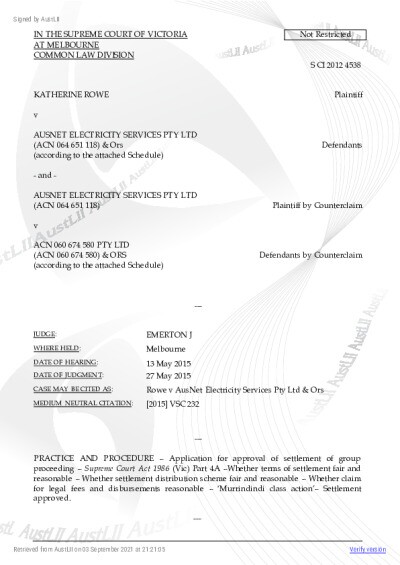
Date
Geographical Area
Pacific
Countries
Australia
Keywords
Case Name
Rowe v AusNet Electricity Services Pty Ltd & Ors
Case Reference
[2015] VSC 232
Name of Court
Supreme Court of Victoria
Key Facts
On 7 February 2009, a bushfire started near Murrindindi. Known as the Murrindindi fire, the bushfire spread widely, almost obliterating the township of Marysville. The Murrindindi fire resulted in the deaths of 40 people and injured many more. It also damaged and destroyed buildings and livestock. It was agreed between the parties that on 7 February a particular power line failed due to arcing between the line and wire supporting the power pole. The live line then broke and fell, landing on a roadside fence – causing at least one wire of the fence to become electrified. The plaintiffs argued that all the fence wires became electrified, which created an electrical path to the ground and produced sparks and embers, which ignited the grass below. However, AusNet Electricity Services argued that the fire started away from the fence, the arcing was likely caused by smoke in the air after the fire started, and the electric current in the fence would not have been sufficiently strong to ignite a fire.
The plaintiff and group members of this class action included those who suffered a personal injury, dependents of those who died, those who suffered loss of or damage to property, and those who lived in or had property in the fire area and suffered economic loss as a result of the fire. They claimed that the defendants had been negligent in the maintenance and inspection of the power lines and poles. This proceeding was settled for $300 million (with no admission of liability) immediately prior to trial; however, s.33V of the Supreme Court Act required the Court to approve the settlement before the group proceeding could be settled.
The plaintiff and group members of this class action included those who suffered a personal injury, dependents of those who died, those who suffered loss of or damage to property, and those who lived in or had property in the fire area and suffered economic loss as a result of the fire. They claimed that the defendants had been negligent in the maintenance and inspection of the power lines and poles. This proceeding was settled for $300 million (with no admission of liability) immediately prior to trial; however, s.33V of the Supreme Court Act required the Court to approve the settlement before the group proceeding could be settled.
Decision and Reasoning
In determining an application for Court approval of a settlement, the Court had to determine whether: i) they considered the proposed settlement to be fair and reasonable as between the parties; and ii) whether the proposed settlement was fair and reasonable as between the recipients of the settlement sum, namely the plaintiff and the group members. The Court stated that they are not relieved of their obligation to complete this assessment even where there is complete absence of substantive objections.
Between the Parties: The Court found that the settlement was fair and reasonable between the parties as the proposed settlement avoids the risk of an adverse result for the plaintiff and group members, there was a high recovery rate of 70% for personal injury and 60% for damage and economic loss (even if the trial award was higher, it would be significantly eroded by non-recoverable costs), a serious and conscientious effort was made to accurately estimate the quantum of the claims, considerable benefit of early finalisation, material advantage in early receipt of funds, and containment of legal costs.
Between Group Members: The Court found that the settlement was fair and reasonable between group members despite the apparent priority of the personal injury claims, especially due to the 80% cap on personal injury claims and the provisions distributing any surplus to the damage and economic loss claims. Furthermore, the Court noted that it was reasonable despite not all group members obtaining an optimal outcome.
Between the Parties: The Court found that the settlement was fair and reasonable between the parties as the proposed settlement avoids the risk of an adverse result for the plaintiff and group members, there was a high recovery rate of 70% for personal injury and 60% for damage and economic loss (even if the trial award was higher, it would be significantly eroded by non-recoverable costs), a serious and conscientious effort was made to accurately estimate the quantum of the claims, considerable benefit of early finalisation, material advantage in early receipt of funds, and containment of legal costs.
Between Group Members: The Court found that the settlement was fair and reasonable between group members despite the apparent priority of the personal injury claims, especially due to the 80% cap on personal injury claims and the provisions distributing any surplus to the damage and economic loss claims. Furthermore, the Court noted that it was reasonable despite not all group members obtaining an optimal outcome.
Outcome
The Court approved the $300 million settlement between the parties.
Link
Disclaimer
This case law summary was developed as part of the Disaster Law Database (DISLAW) project, and is not an official record of the case.
Document
Document